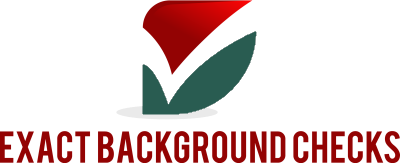Steps to Ensure Accurate Onsite Drug Screening
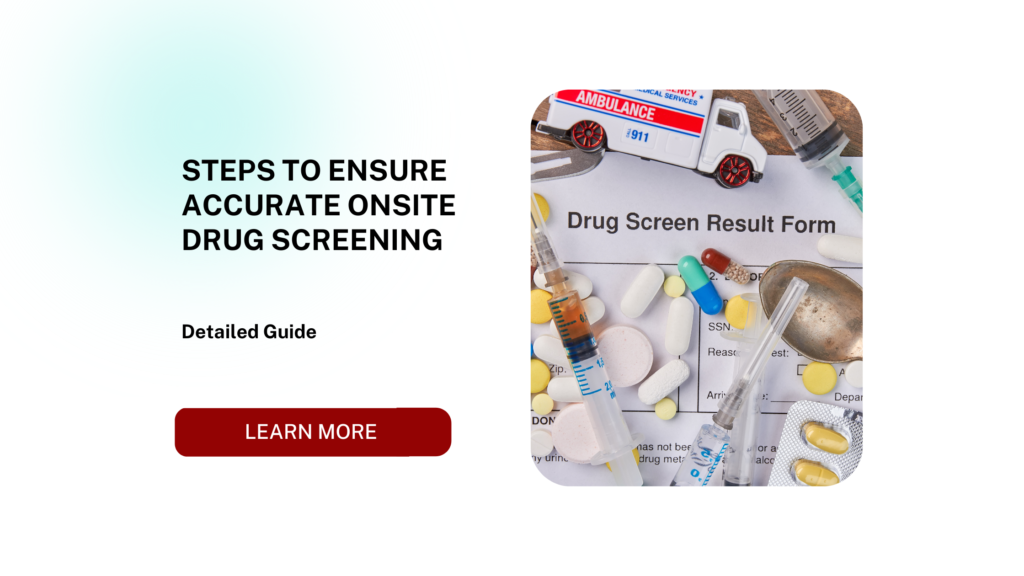
Onsite Drug Screening: Introduction and Benefits
Onsite drug screening is a testing method where drug tests are conducted directly at a workplace, school, event venue, or any designated location. Unlike traditional offsite drug testing, which requires individuals to visit clinics or laboratories, onsite screening simplifies the process by bringing testing services to the desired location.
This method has gained widespread popularity across industries and organizations due to its convenience, efficiency, and ability to provide rapid results. Onsite drug screening helps organizations maintain a safe, productive, and compliant environment, making it an essential tool in modern workplaces and beyond.
The Importance of Onsite Drug Screening
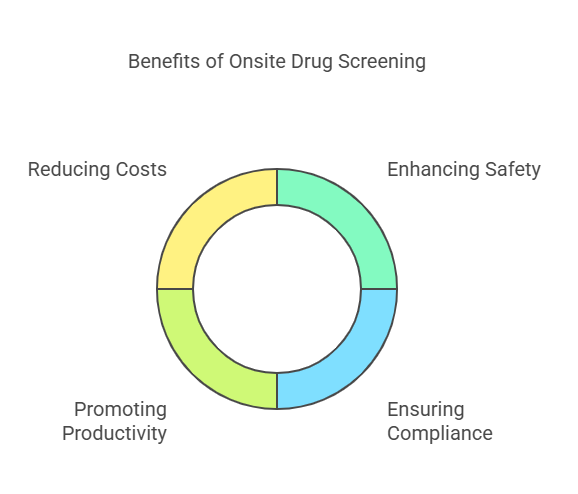
Substance abuse poses significant risks in professional and educational environments. It can lead to accidents, reduced productivity, absenteeism, and even legal liabilities. Onsite drug screening addresses these issues by:
- Enhancing Safety: Drug-free policies help prevent accidents and injuries caused by impaired individuals.
- Ensuring Compliance: Many industries, such as transportation and healthcare, require routine drug testing to comply with federal and state regulations.
- Promoting Productivity: By identifying and addressing substance abuse issues, organizations can foster a more focused and efficient workforce.
- Reducing Costs: Early detection of substance abuse can prevent costly workplace incidents and reduce healthcare expenses.
Key Applications of Onsite Drug Screening
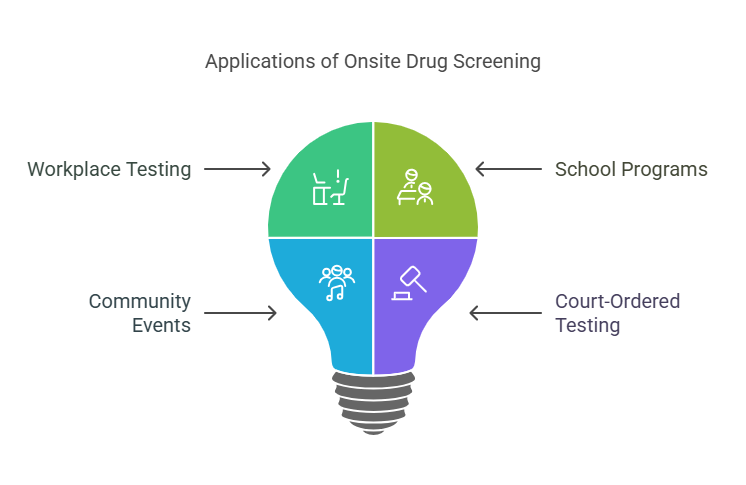
- Workplace Testing:
Employers use onsite testing to ensure that their employees adhere to drug-free workplace policies. Common scenarios include:- Pre-Employment Testing: Screening candidates before hiring to ensure a drug-free workforce.
- Random Testing: Conducting unannounced tests to deter substance use among employees.
- Post-Incident Testing: Investigating whether drug use played a role in workplace accidents or incidents.
- School Programs:
Educational institutions implement drug screening to discourage substance abuse among students and promote a safe learning environment. - Community Events:
Organizers of large-scale events, such as concerts or festivals, use onsite testing to ensure public safety and discourage drug-related incidents. - Court-Ordered Testing:
Courts may mandate onsite drug screening for individuals on probation or involved in custody disputes to ensure compliance with legal requirements.
Advantages of Onsite Drug Screening
Onsite drug screening offers numerous benefits that make it a preferred choice for organizations and institutions:
1. Convenience and Time Efficiency
- Onsite testing eliminates the need for employees, students, or participants to travel to an offsite clinic or lab.
- Tests can be conducted during work hours, minimizing disruptions to schedules and workflows.
2. Reduced Employee Downtime
- By conducting drug tests onsite, employees spend less time away from their jobs.
- Quick setup and testing processes allow individuals to return to their tasks promptly.
3. Faster Results
- Many onsite drug testing methods, such as instant urine or saliva tests, provide results within minutes.
- Organizations can make informed decisions quickly, particularly in urgent situations like post-incident investigations.
4. Cost Savings
- Onsite drug screening reduces expenses associated with transportation, lost productivity, and clinic fees.
- Organizations can test multiple individuals simultaneously, further optimizing costs.
5. Enhanced Privacy and Confidentiality
- Onsite testing allows for greater control over the testing process, ensuring that results remain confidential.
- Designated testing areas maintain privacy for individuals being tested.
6. Flexibility and Customization
- Onsite drug screening services can be tailored to meet the specific needs of an organization.
- Whether it’s a one-time event or a recurring program, onsite testing can be scheduled at the organization’s convenience.
Infographic Idea: Top Benefits of Onsite Drug Screening
A visually appealing infographic could summarize these benefits:
- Convenience (depicted by a clock or calendar).
- Cost Savings (dollar sign or coin icon).
- Faster Results (stopwatch icon).
- Improved Privacy (shield icon).
- Flexibility (arrows indicating customization).
How Onsite Drug Screening Addresses Workplace Challenges
| Challenge | How Onsite Drug Screening Helps |
|---|---|
| Substance Abuse | Identifies employees using drugs, enabling timely intervention. |
| Workplace Accidents | Reduces the risk of accidents by maintaining a drug-free workforce. |
| Compliance with Regulations | Ensures adherence to industry-specific drug testing requirements. |
| Loss of Productivity | Improves focus and efficiency by identifying and addressing substance issues. |
| Legal Liabilities | Mitigates risks by maintaining a safe and compliant workplace. |
Onsite Drug Screening vs. Offsite Testing
1. Convenience and Accessibility
- Onsite Testing: The testing process comes to the organization, eliminating the need for transportation.
- Offsite Testing: Employees must travel to clinics, resulting in additional time and logistical challenges.
2. Cost Efficiency
- Onsite Testing: Minimizes expenses associated with travel and employee downtime.
- Offsite Testing: Increases costs due to transportation, clinic fees, and extended work absences.
3. Time Savings
- Onsite Testing: Testing is completed quickly, often within a few minutes.
- Offsite Testing: Longer processes due to travel and administrative delays.
4. Result Turnaround
- Onsite Testing: Instant tests provide results immediately, while lab-confirmed tests are expedited.
- Offsite Testing: Results may take longer due to sample transport and processing times.
Why Onsite Drug Screening is Essential for Businesses
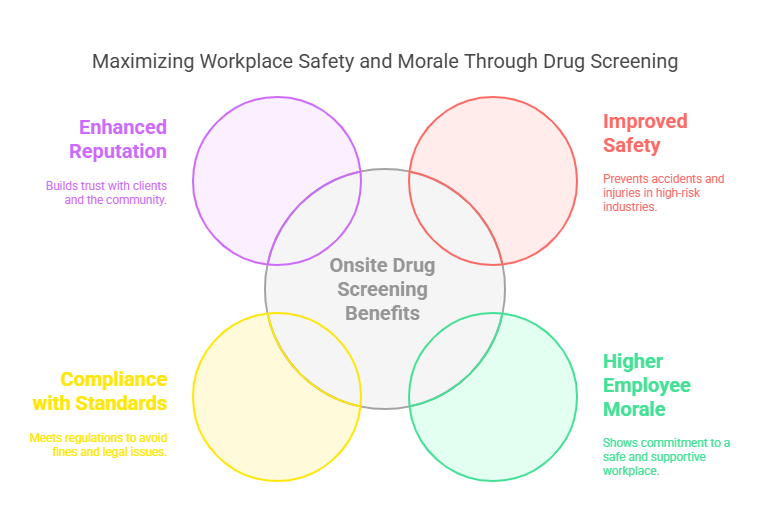
For businesses, maintaining a drug-free environment is not just a legal requirement but also a strategic advantage. Here’s why onsite drug screening is crucial for organizations:
- Improved Safety: Prevents accidents and injuries, especially in high-risk industries like construction and transportation.
- Higher Employee Morale: Demonstrates a commitment to a safe and supportive workplace.
- Compliance with Industry Standards: Meets federal and state regulations, avoiding potential fines or legal issues.
- Enhanced Reputation: Builds trust with clients, customers, and the community by ensuring a drug-free workforce.
Integrating Onsite Drug Screening into Workplace Policies
To successfully implement onsite drug screening, organizations should:
- Develop Clear Policies: Include drug testing guidelines in employee handbooks.
- Communicate Expectations: Inform employees about the purpose and benefits of drug screening programs.
- Partner with Reliable Providers: Work with experienced service providers to ensure accuracy and compliance.
- Provide Support for Employees: Offer assistance programs for individuals who may need help overcoming substance abuse.
How Onsite Drug Screening Works
Onsite drug screening is a streamlined process designed to provide accurate, efficient, and timely drug test results. Below is a detailed step-by-step explanation of how onsite drug testing is conducted:
Step 1: Setting Up the Testing Environment
The onsite drug screening provider sets up a designated testing area. This can be a mobile unit, a designated room within the workplace, or an outdoor space equipped for privacy and security.
- Mobile Testing Units: Vehicles outfitted with all necessary equipment for collecting and processing samples.
- Temporary Testing Sites: Rooms or conference areas transformed into secure spaces for conducting tests.
- Privacy Measures: Ensuring the testing area complies with privacy standards to protect the dignity of participants.
Step 2: Collecting Samples
Depending on the organization’s requirements, different types of samples are collected during onsite testing:
| Sample Type | Key Features | Common Uses |
|---|---|---|
| Urine | Non-invasive, detects recent drug use. | Pre-employment and random testing. |
| Saliva | Easy to collect, detects very recent substance use. | Post-incident testing and roadside checks. |
| Hair | Detects long-term drug use over months. | High-level employee or legal investigations. |
| Breath | Measures alcohol levels instantly. | DOT compliance and workplace safety checks. |
The type of test chosen depends on factors like the drugs being screened for, testing policies, and legal requirements.
Step 3: Screening Methods
Onsite drug screening utilizes two primary methods:
- Instant Testing:
- Provides results within minutes.
- Uses testing kits for urine or saliva samples.
- Common for pre-employment or random drug testing.
- Lab-Confirmed Testing:
- Samples are sent to certified laboratories for detailed analysis.
- Used when confirmatory results are required for legal or compliance purposes.
Step 4: Communication of Results
Once the tests are complete, the results are securely communicated to the employer or requester. Depending on the method used, results may be delivered:
- Instantly for rapid onsite tests.
- Within 24-48 hours for lab-confirmed testing.
Key Technologies in Onsite Drug Screening
Modern onsite drug screening relies on advanced technologies for accurate and reliable results:
- Point-of-Care Devices: Portable testing devices for rapid, reliable onsite analysis.
- Electronic Chain of Custody Forms (eCCF): Digital forms that streamline the documentation process and ensure compliance.
- Mobile Apps for Reporting: Apps that provide instant access to results and reports, enhancing convenience for employers.
Applications of Onsite Drug Screening
Onsite drug screening is versatile and can be tailored to various industries and situations. Here are the primary applications:
1. Pre-Employment Drug Testing
Employers often conduct drug tests as part of the hiring process to ensure they select candidates who are fit for their roles.
- Purpose:
- Prevent workplace incidents caused by substance abuse.
- Reduce the risk of hiring individuals with drug-related issues.
- Benefits:
- Promotes a safe and drug-free workplace culture.
- Reduces costs associated with turnover and accidents.
2. Random Drug Testing
Random drug testing is an effective deterrent against substance abuse in the workplace.
- How It Works:
- Employees are selected randomly to participate in drug tests.
- The element of surprise ensures the effectiveness of the program.
- Industries:
- Transportation, manufacturing, and healthcare commonly use random testing.
3. Post-Incident Drug Testing
Following a workplace accident or safety violation, onsite drug screening is conducted to determine whether substance use was a contributing factor.
- Purpose:
- Identifies potential causes of incidents.
- Protects employers from liability in legal investigations.
- Advantages:
- Provides immediate results, enabling quick decision-making.
4. Compliance Testing in Regulated Industries
Certain industries, such as transportation and healthcare, are required by law to implement routine drug testing programs.
- Examples:
- Department of Transportation (DOT) Testing: Ensures drivers and operators are free from substance abuse.
- Healthcare Professionals: Protects patients by ensuring caregivers are unimpaired.
5. School and Community Programs
Educational institutions and community organizations use onsite drug screening to discourage substance abuse among students and members.
- Advantages:
- Promotes a drug-free environment.
- Helps identify individuals in need of intervention or support.
6. Post-Rehabilitation Testing
For individuals returning to work after completing rehabilitation programs, onsite drug screening ensures continued sobriety.
- Purpose:
- Reinforces accountability.
- Supports individuals in maintaining a substance-free lifestyle.
Onsite vs. Offsite Drug Screening
To better understand the benefits of onsite drug screening, let’s compare it with traditional offsite methods:
| Factor | Onsite Drug Screening | Offsite Drug Screening |
|---|---|---|
| Convenience | Testing occurs at the workplace or site. | Requires travel to clinics or labs. |
| Time Efficiency | Minimal downtime for employees. | Longer process due to travel and wait times. |
| Cost | Reduces transportation and productivity loss. | Higher costs due to extended absences. |
| Privacy | Controlled environment for confidentiality. | May lack privacy due to external settings. |
| Result Turnaround | Instant results or expedited lab testing. | Longer wait times for lab results. |
Challenges in Onsite Drug Screening
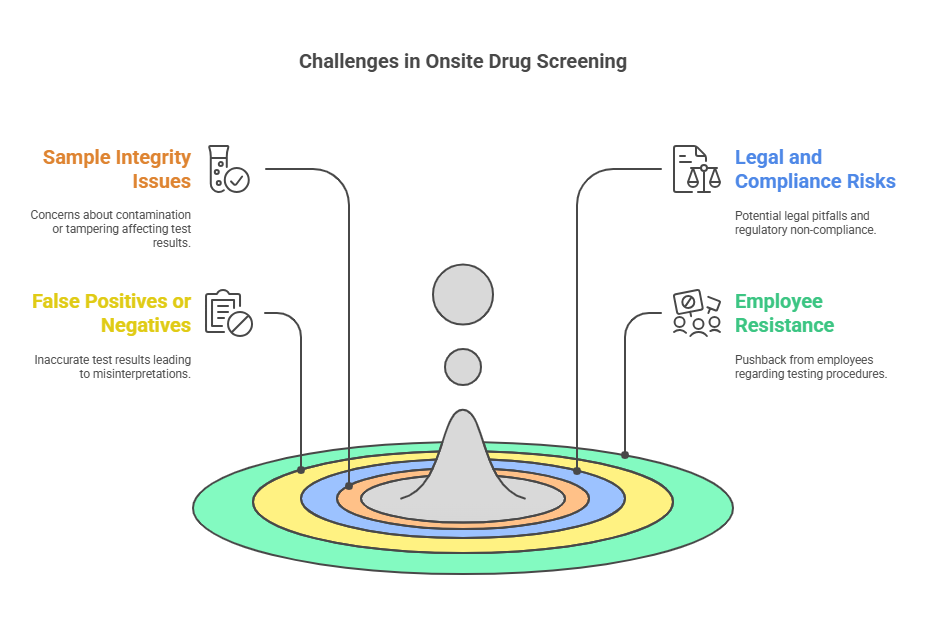
While onsite drug screening offers numerous benefits, it’s not without challenges. Below are common obstacles and how they can be addressed:
1. Sample Integrity Issues
- Challenge: Tampering or adulteration of samples.
- Solution: Use of temperature strips, tamper-evident seals, and trained professionals to monitor the process.
2. Legal and Compliance Risks
- Challenge: Non-compliance with federal and state regulations.
- Solution: Partnering with providers like Exact Background Checks to ensure legal adherence.
3. False Positives or Negatives
- Challenge: Instant tests may yield inaccurate results in rare cases.
- Solution: Confirmatory testing at certified labs ensures accuracy.
4. Employee Resistance
- Challenge: Employees may feel targeted or distrust the process.
- Solution: Transparent communication about the purpose and benefits of testing programs.
Why Choose Exact Background Checks for Onsite Drug Screening?
Partnering with a reliable provider is critical to the success of onsite drug testing programs. Exact Background Checks offers:
- Comprehensive Testing Options: From pre-employment to compliance testing, tailored to organizational needs.
- State-of-the-Art Technology: Advanced tools and methods for accurate and fast results.
- Flexible Scheduling: Accommodates the unique timelines of businesses and organizations.
- Regulatory Compliance: Ensures all tests meet federal and state laws.
- Dedicated Support: Experienced professionals who guide employers through the testing process.
